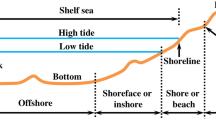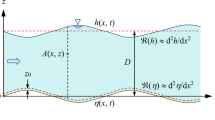Conclusions
-
1.
The generation of sand ridges on an even sand bottom in a certain interval of the flow velocities occurs due to the effect of stationary waves on the bottom of the flow.
-
2.
The ridges occurring serve as the source of a new structure of the stationary waves generating new sand ridges, and the spectrum of the waves and ridges becomes multimodal.
-
3.
Reconstruction of the stationary waves and sand ridges continues until a stable structure is established, the time of establishment of such a structure coinciding with the end of the formation of the channel.
-
4.
The length of the stationary waves coincides with the length of the sand ridges, the picture of the sand surface represents a mirror image of the water surface: for all wavelengths the troughs of the ridges correspond to the crests of the waves.
-
5.
The height of the sand ridge for a given depth of the flow is uniquely determined by the height of the stationary waves.
Similar content being viewed by others
Literature cited
M. A. Velikanov, Dynamics of Channel Flows [in Russian], Gostekhizdat, Moscow (1955).
N. T. Povalo-Sheikovskii, “The origin of dunes,” Izv. Akad. Nauk SSSR, Ser. Geofiz., No. 23, 76 (1938).
B. A. Shylyak, “Some processes of the interaction of a wave flow with a deformed bottom at low velocities,” Tr. Akad. Nauk SSSR,18, 54 (1961).
N. A. Mikhailova, Transport of Solid Particles by Turbulent Water Flows [in Russian], Gidrometeoizdat, Leningrad (1966), p. 290.
P. A. Volkov, “Investigation of processes of interaction of a water flow with the bottom,” in: Experimental and Theoretical Investigation of Coastal Processes [in Russian], Nauka, Moscow (1965), p. 94.
K. V. Grishanin, Dynamics of Channel Flow [in Russian], Gidrometeoizdat, Leningrad (1979), p. 311.
B. A. Shulyak, “Nature of wave periodicity on the surface of a granular mass,” Okeanologiya,8, No. 6 (1968).
B. B. Kadomtsev and V. I. Rydnik, Waves Around Us [in Russian], Znanie, Moscow (1981).
M. J. Lighthill, Waves in Fluid [Russian translation], Mir, Moscow, 598 (3, 9) (1981).
T. P. Kromskaya and O. N. Mel'nikova, Experimental Investigation of the Formation of Sand Ridges in Channel Flows [in Russian], Deposited at VINITI, No. 8497–135 (1985).
N. A. Mikhailova, O. B. Shevchenko, and M. M. Selyametov, “Laboratory investigation of stable canal channels,” Gidrotekh. Stroit., No. 7, 41 (1980).
Additional information
Translated from Gidrotekhnicheskoe Stroitel'stvo, No. 11, pp. 26–29, November, 1986.
Rights and permissions
About this article
Cite this article
Mel'nikova, O.N., Shevchenko, O.B. & Emel'yanov, A.V. Investigation of sand ridges in a laboratory channel flow. Hydrotechnical Construction 20, 647–652 (1986). https://doi.org/10.1007/BF01427345
Issue Date:
DOI: https://doi.org/10.1007/BF01427345




